Related Research Articles

Backgammon is a two-player board game played with counters and dice on tables boards. It is the most widespread Western member of the large family of tables games, whose ancestors date back nearly 5,000 years to the regions of Mesopotamia and Persia. The earliest record of backgammon itself dates to the 17th century England; being descended from the 16th-century game of Irish.
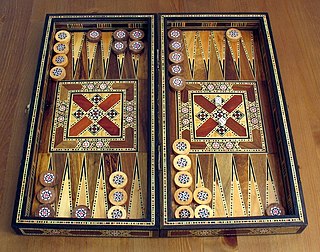
Tables games are a class of board game that includes backgammon and which are played on a tables board, typically with two rows of 12 vertical markings called points. Players roll dice to determine the movement of pieces. Tables games are among the oldest known board games, and many different varieties are played throughout the world. They are called 'tables' games because the boards consist of four quadrants or 'tables'. The vast majority are race games, the tables board representing a linear race track with start and finish points, the aim being to be first to the finish line, but the characteristic features that distinguish tables games from other race games are that they are two-player games using a large number of pieces, usually fifteen per player.
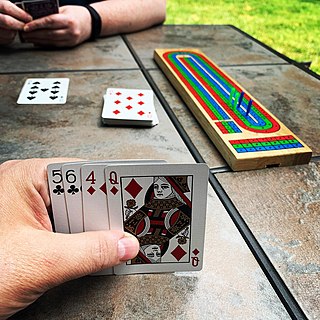
Cribbage, or crib, is a card game, traditionally for two players, that involves playing and grouping cards in combinations which gain points. It can be adapted for three or four players.

Francis Willughby FRS was an English ornithologist and ichthyologist, and an early student of linguistics and games.
Ruff and Honours, Ruffe and Trump or Slamm was an English trick-taking card game that was popular in the 16th and 17th centuries; it was superseded in the 18th century by Whist.
Hoyle's Official Book of Games is a series of games developed and published by Sierra On-Line. Volume 1, released in 1989, featured multi-player card games. Volume 2, released in 1990, featured 28 varieties of Solitaire. Volume 3, released in 1991, featured board games. Volume 4, was a remake of Volume 1, with two additional games. Sierra continued to publish more games to the series up to its demise. Encore Software has continued publishing entries to the series since then. According to Hoyle 1, it was essentially a spiritual sequel to Sierra's Hi-Res Cribbage (1981).

Post and Pair or Post and Pare is a gambling card game that was popular in England in the 16th and 17th centuries — another name of the game was Pink. It is based on the same three-card combinations, namely prial, found in related games of this family.
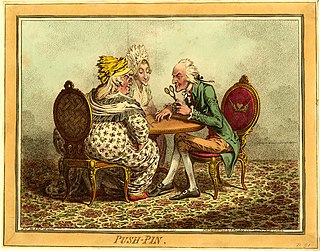
Push-pin was an English child's game played from the 16th until the 19th centuries. It is also known as "put-pin", and it is similar to Scottish games called "Hattie" and "Pop the Bonnet". In philosophy it has been used as an example of a relatively worthless form of amusement.
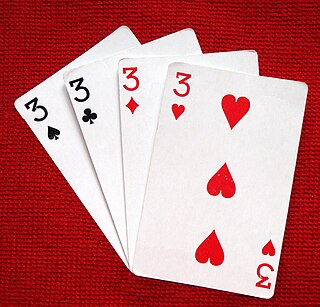
Put, occasionally Putt, is an English tavern game first recorded in the 16th century and later castigated by 17th century moralists as one of ill repute. It belongs to a very ancient family of trick-taking card games and bears close similarities a group known as Truc, Trut,Truque, also Tru, and the South American game Truco. Its more elaborate cousin is the Catelan and Spanish game of Truc, which is still much played in many parts of Southern France and Spain.

Quinze, Quince, also known as Ace-low, is a 17th-century French banking game of Spanish origin that was much patronized in some parts of Europe. It is considered a forerunner of the French Vingt-et-un, a game very popular at the court of Louis XV, and also a two-player simplification of the modern game of Blackjack.
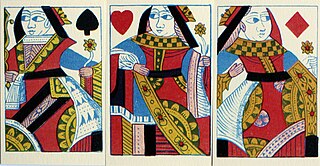
Gleek is an English card game for three persons. It is played with a 44-card pack and was popular from the 16th century through the 18th century.

An Ace-Ten game is a type of card game, highly popular in Europe, in which the Aces and Tens are of particularly high value.
The Compleat Gamester, first published in 1674, is one of the earliest known English-language games compendia. It was published anonymously, but later attributed to Charles Cotton (1630–1687). Further editions appeared in the period up to 1754 before it was eclipsed by Mr. Hoyle's Games by Edmond Hoyle (1672–1769).

Losing Lodam is an historical English card game for three or more players. It is a 'negative' game like Hearts whereby the aim is to avoid taking tricks with certain cards known as loaders.

Laugh and Lie Down or Laugh and Lay Down is an historical English card game for five players and the earliest example of a European game of the fishing family.
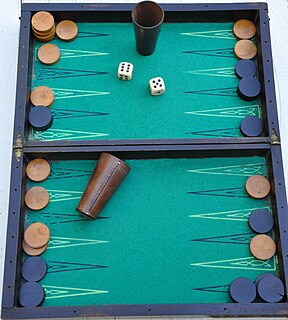
The following is a glossary of terms used in tables games, essentially games played on a Backgammon-type board. Terms in this glossary should not be game-specific, but applicable to a range of tables games.
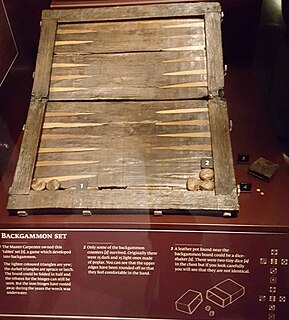
Irish or the Irish Game was an Anglo-Scottish tables game for two players that was popular from the 16th to the mid-18th centuries before being superseded by its derivative, the "faster paced" backgammon. In its day, Irish was "esteemed among the best games at Tables." Its name notwithstanding, Irish was one of the most international forms of tables games, the equivalent of French toutes tables, Italian tavole reale and Spanish todas tablas, the latter name first being used in the 1283 El Libro de los Juegos, a translation of Arabic manuscripts by the Toledo School of Translators.

Ludus Anglicorum, also called the English Game, is an historical English tables game for two players using a board similar to that used today for Backgammon and other games. It is a "strategic game for serious game-players" and was well known in the Middle Ages. At one time it was considered the most popular tables game in England.

Ticktack or Tick-Tack, is an historical English tables game for two players using a board similar to that used today for Backgammon and other tables games. Like its much more elaborate French counterpart, Trictrac, it has the unusual feature that there are several different ways in which it can be won, including Toots and Rovers.

Doublets or queen's game is an historical English tables game for two people which was popular in the 17th and 18th centuries. Although played on a board similar to that now used for backgammon, it is a simple game of hazard bearing little resemblance to backgammon. Very similar games were played in mainland Europe, the earliest recorded dating to the 14th century.
References
- ↑ O'Callaghan, Michelle (2007). The English Wits: Literature and Sociability in Early Modern England. Cambridge University Press. ISBN 0-521-86084-9.